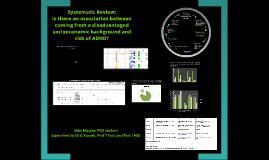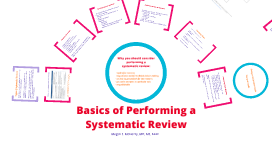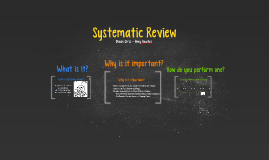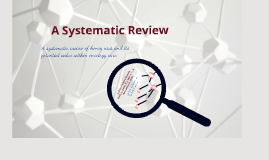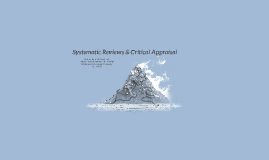Systematic Review
Transcript: Results & Limitations Nurses in the emergency room are exposed to high incidents of violence because of dangerous patients, long wait times that cause people to get angry, lack of security, and lack of intervention training for the staff. The purpose of this study was to determine what emergency rooms were reporting about workplace violence (WPV) and provide research to guide and implement best practice policies that will protect healthcare workers. The review of literature in this study addressed the need for additional research on why more employees do not report WPV and research on ways to provide safer working conditions for staff. "The ED is a particularly vulnerable setting for workplace violence, and because of a lack of standardized measurement and reporting mechanisms for violence in healthcare settings, data are scarce" (Gacki-Smith, Juarez, Boyett, Homeyer, Robinson, & MacLean., 2009). Future Research & Clinical Practice Taylor, J. L., & Rew, L. (2010, December). A systematic review of literature: workplace violence in the emergency department.. Journal Of Clinical Nursing, 20(), 1072-1085. doi:10.1111/j.1365-2702.2010.03342.x Gacki-Smith, J., Juarez, A., Boyett, L., Homeyer, C., Robinson, L., & MacLean, S., (2009, July/August). Violence against Nurses working in US Emergency Departments. The Journal of Nursing Administration, 39(7/8), 340-349. "A systematic review of the literature: workplace violence in the emergency department" (Taylor & Rew. 2010) The articles reviewed indicated multiple variations in definitions of WPV. Workplace violence was defined as verbal abuse, physical abuse, spitting, biting, sexual assault, stalking, and intimidation. The articles reviewed determined that WPV is prevalent among all staff members in ED's worldwide. This systematic review determined that most of the articles reviewed were descriptive methods. The researchers believed experimental design or predictive methods would have been a more accurate method. The authors of the article believed the inconsistencies of WPV definitions were a barrier to reporting accurate incidence rates and cross-comparing studies (Gacki-Smith, Juarez, Boyett, Homeyer, Robinson, & MacLean, 2009). Furthermore, incidence and occurrence were the major focus of the literature reviewed. The majority of the studies concluded that reporting of WPV is under-reported due to staff members believing that violence is part of the job. Additionally, staff associated substance abuse and mental illness as contributing factors to WPV. Some of the limitations to the literature review were the chosen time period. The authors believed if older data had been reviewed, additional valuable information could have been used in the analysis. Additionally, because the author was a nurse in the ED it was possible that the literature review was biased. Design & Measurements References Conclusion Kimberly Keene NUR518 November 30, 2012 Dr. Pat Shannon The study conducted in this article found multiple areas that could be further researched. This study concluded there are many instances of workplace violence not reported because of unknown reasons that indicated an area for further research. "In the future, ED staff should become more accountable for making their own environment safe, which also includes reporting incidents of WPV" (Gacki-Smith, Juarez, Boyett, Homeyer, Robinson, & MacLean., 2009). Additionally, studies that include interventions that decrease workplace violence that will provide guidelines for best practices. Research is also needed to develop evidence-based practices that will improve working conditions of healthcare workers. Instruments to measure the validity and reliability of studies regarding workplace violence need to be developed to provide a consistent method of obtaining data. Purpose & Problem The study reviewed literature that had used emergency rooms of different sizes and types that ranged from community hospitals, pediatric emergency rooms, to large trauma centers for their study setting. These studies were conducted mostly in the United States but some studies were conducted in Australia and Europe. The sampling size ranged from the entire staff in the ED to specific professional staff including physicians. The smallest sample size was eight with the largest sample size over 3500 staff members. The average response rate for the studies was a little over 60%. Convenient sampling was used for a majority of the studies but random sampling was used in only one of the studies. "The ED is a particularly vulnerable setting for workplace violence, and because of a lack of standardized measurement and reporting mechanisms for violence in healthcare settings, data are scarce" (Gacki-Smith, Juarez, Boyett, Homeyer, Robinson, & MacLean., 2009). This systematic review used 16 articles, eight studies from the USA, three from Europe, and five from Australia (Gacki-Smith, Juarez, Boyett, Homeyer, Robinson, & MacLean., 2009). The quantitative






